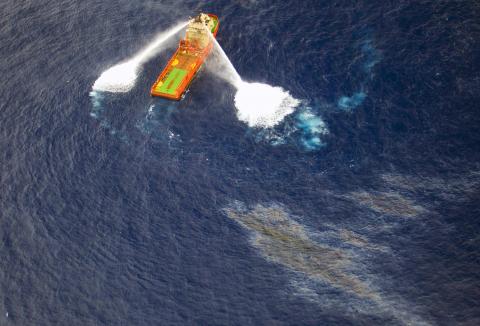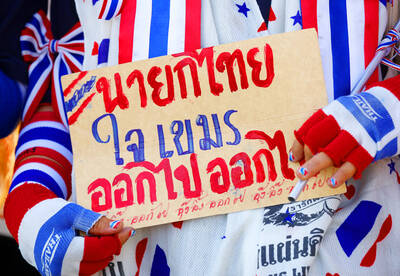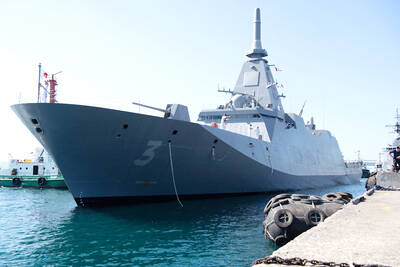US oil company Chevron promised to fully clean up a spill off Brazil’s coast, Chevron Brazil chief executive George Buck said on Sunday, taking responsibility for an accident that has become a major test for one of the world’s fastest-growing oil frontiers.
The leak from the undersea well, which is owned in partnership with Brazil’s state-controlled Petrobras and a Japanese consortium, has been plugged and the residual oil flow from undersea rock is now “more than 10 barrels,” but “less than hundreds of barrels” per day, Buck said.
“Chevron takes full responsibility for this incident,” Buck told reporters in Rio de Janeiro. “We will share the lessons learned here in the hope that this sort of incident won’t happen again in Brazil or anywhere else in the world.”

Photo: AFP
The spill, one of the largest to hit Brazil’s growing offshore oil industry, has raised questions about its safety and ability to respond to accidents. Oil companies in Brazil are testing the limits of drilling as they seek oil at depths as much as 7km below the ocean surface, which puts equipment and people under strains often compared with those for space flight.
Opposition to offshore drilling is growing worldwide in the wake of the estimated 4 million barrel BP Deepwater Horizon spill in the Gulf of Mexico last year. Brazil’s Federal Police are probing the spill for possible criminal action.
Buck told a news conference that the spill was the result of an underestimate of pressure in the offshore oil reservoir being targeted. At the same time, the company overestimated the strength of undersea rock through which they were drilling.
As a result, high pressure oil was able to leak into the well borehole, overcoming a liquid sealant and well cleaning fluid known as “mud.” Because of the low pressure estimate, the mud was mixed “too light” to keep the oil under control.
While the well was immediately shut off, the pressure from the so-called “kick” as oil rushed up through the well mud bore-hole, or outside edge of the well structure, to crack.
Oil then seeped through more than 500m of crevices and porous rock to the seafloor. From there, it bubbled more than a kilometer up to the ocean surface.
Chevron, which experienced the pressure “kick” on Nov. 7, has come under criticism in Brazilian newspapers for failing to provide an immediate explanation for the spill and for a failure to provide a clear estimate of how much oil has leaked into the ocean.
The company, though, says the problem was brought under control within four days despite major transportation, weather, geological and environmental challenges.
“It’s an accomplishment to bring something like this under control in four days in deep water,” Buck said. “We were 160km from the coast and 300km from our base [in Rio de Janeiro].”
At first Chevron did not realize it was responsible for the leak that was discovered on Nov. 8 by workers on a Petrobras platform southeast of the Chevron well-site, he said.
As the blowout preventer worked as designed after the pressure kick, and no oil was leaking from around the well head, Chevron assumed the leak it came from the nearby Petrobras platform or from a Petrobras undersea oil pipeline that runs on the seabed near the leak, Buck said.
Failure of the blow-out preventer was the cause of the Deepwater Horizon disaster.
After searching the ocean floor with remote-controlled submarines — the depths are too great for human divers — the leaks were found, Buck said.

Eleven people, including a former minister, were arrested in Serbia on Friday over a train station disaster in which 16 people died. The concrete canopy of the newly renovated station in the northern city of Novi Sad collapsed on Nov. 1, 2024 in a disaster widely blamed on corruption and poor oversight. It sparked a wave of student-led protests and led to the resignation of then-Serbian prime minister Milos Vucevic and the fall of his government. The public prosecutor’s office in Novi Sad opened an investigation into the accident and deaths. In February, the public prosecutor’s office for organized crime opened another probe into

RISING RACISM: A Japanese group called on China to assure safety in the country, while the Chinese embassy in Tokyo urged action against a ‘surge in xenophobia’ A Japanese woman living in China was attacked and injured by a man in a subway station in Suzhou, China, Japanese media said, hours after two Chinese men were seriously injured in violence in Tokyo. The attacks on Thursday raised concern about xenophobic sentiment in China and Japan that have been blamed for assaults in both countries. It was the third attack involving Japanese living in China since last year. In the two previous cases in China, Chinese authorities have insisted they were isolated incidents. Japanese broadcaster NHK did not identify the woman injured in Suzhou by name, but, citing the Japanese

YELLOW SHIRTS: Many protesters were associated with pro-royalist groups that had previously supported the ouster of Paetongtarn’s father, Thaksin, in 2006 Protesters rallied on Saturday in the Thai capital to demand the resignation of court-suspended Thai Prime Minister Paetongtarn Shinawatra and in support of the armed forces following a violent border dispute with Cambodia that killed more than three dozen people and displaced more than 260,000. Gathered at Bangkok’s Victory Monument despite soaring temperatures, many sang patriotic songs and listened to speeches denouncing Paetongtarn and her father, former Thai prime minister Thaksin Shinawatra, and voiced their backing of the country’s army, which has always retained substantial power in the Southeast Asian country. Police said there were about 2,000 protesters by mid-afternoon, although

MOGAMI-CLASS FRIGATES: The deal is a ‘big step toward elevating national security cooperation with Australia, which is our special strategic partner,’ a Japanese official said Australia is to upgrade its navy with 11 Mogami-class frigates built by Japan’s Mitsubishi Heavy Industries, Australian Minister for Defence Richard Marles said yesterday. Billed as Japan’s biggest defense export deal since World War II, Australia is to pay US$6 billion over the next 10 years to acquire the fleet of stealth frigates. Australia is in the midst of a major military restructure, bolstering its navy with long-range firepower in an effort to deter China. It is striving to expand its fleet of major warships from 11 to 26 over the next decade. “This is clearly the biggest defense-industry agreement that has ever